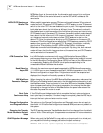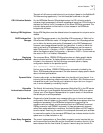
40 NETBUILDER SOFTWARE VERSION 11.1 RELEASE NOTES
NETBuilder II port at the central site. An alternative work around is to configure
APPN with DLSw at the central site and to use the CEC’s MAC address at the
remote site.
APPN CP-CP Sessions on
Parallel TGs
When parallel transmission groups (TGs) are configured between 3Com network
nodes and both TGs support CP-CP sessions, a CP-CP session on one TG does not
switch to the other TG if the user disables the port or path. This happens because
both sides learn about the link failure at different times. The network node with
the disabled port or path learns about the link failure right away and tries to bring
CP-CP sessions up on the second TG. However, the second network node does not
learn about the link failure until LLC2 times out; because it thinks the link is still
up, the second network node does not allow CP-CP sessions to start on the
second TG. After five attempts at bringing up CP-CP sessions on the second TG,
the second TG will be flagged as not supporting CP-CP sessions, preventing CP-CP
sessions from coming up on that second TG. To prevent this situation, manually
stop the first TG by entering the SET -APPN LinkStaCONTrol <LinkName>
Deactivate command before disabling the port/path. By doing this, both network
nodes will learn that the link has gone down at the same time, and CP-CP session
can be activated on the second TG.
ATM Connection Table In a LAN Emulation environment with many LAN Emulation Servers (LESs), a
performance drop may occur when the NETBuilder bridge/router is able to connect
to the LAN Emulation Configuration Server (LECS), but many of the LESs are down
or unreachable. Disabling the ETHATM virtual ports corresponding to the
unreachable LESs will alleviate this situation.
Baud Rates for
Async PPP
Although the maximum asynch speed supported by NETBuilder software version
11.1 is 38.4 bps, no error message is reported if the BAud parameter in the -PATH
Service is configured to a larger value. A higher baud rate will be accepted and
displayed, but the path will actually operate at 38.4 bps.
BGP MaxPeers
Parameter Changes
When changing the value of the BGP Service MaxPeers parameter, make sure that
BGP control is disabled and all peers are in the idle state before attempting to set
the MaxPeers value. There is a period of time after BGP control has been disabled
when the peers are flushing the routes in preparation for entering the idle state.
Attempting to change the value of MaxPeers before the peers have entered the
idle state may cause the router to crash.
Boot Cycle
Continuous Loop
If the OfficeConnect bridge/router fails to complete the boot cycle and enters a
boot cycle loop (for example, if the boot image is corrupted), press the ESC key to
interrupt the boot cycle and enter monitor mode.
Change Configuration
and Diagnostic Menu
The options on the Change Configuration and Diagnostic menu do not apply to
the model 1x1 OfficeConnect bridge/router because ISDN ports are not present on
this system.
Changing the Transfer
Mode Parameter Default
Value
The PATH service parameter TransferMode should not be changed from its default
value of AUto. Other settings of this parameter are reserved for future extensions.
CHAP Rejection Message When using only the SysCallerID to map calls on a dynamic path to a virtual port,
you may see the following message just before the path comes up:
WARNING: CHAP on Port !<port> rejected; No AuthLocalUser configured!


















